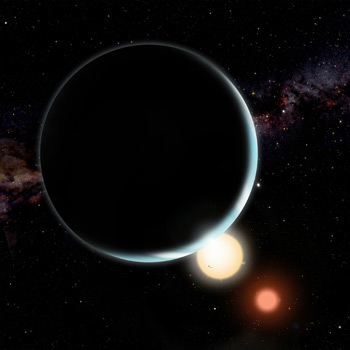If there’s a bright center to the Universe, astronomers have found the planet it’s farthest from. Called Kepler-16b, it’s a Saturn-like world which has the distinction of being the first discovered to orbit both Sun-like stars in a binary system.
 OK, Star Wars references aside, this is pretty cool. Most of the planets being found around other stars are orbiting single stars. A very few – like a possible planet orbiting Gamma Cephei – orbit one of the stars in a binary system, and some (like NN Serpentis b and c) orbit both stars, but one of them is a dead star like a white dwarf or a neutron star.
OK, Star Wars references aside, this is pretty cool. Most of the planets being found around other stars are orbiting single stars. A very few – like a possible planet orbiting Gamma Cephei – orbit one of the stars in a binary system, and some (like NN Serpentis b and c) orbit both stars, but one of them is a dead star like a white dwarf or a neutron star.
Unlike those, Kepler-16 is a binary where both stars, though dinky, are bona-fide stars like the Sun, and the planet orbits both. Actually, how it was found is pretty nifty. The orbiting Kepler observatory is designed to stare at over 100,000 stars and detect the tell-tale drop in light when a planet transits (that is, from our point of view passes directly in front of) its parent star. Kepler has found a lot of planet candidates this way – well over 1200!
Kepler-16 is one (OK, two) of those stars (hence the name), located about 200 light years from Earth. The two stars are eclipsing binaries, meaning that we are viewing them from Earth in the plane of their orbit. Twice every orbital period, one of the stars blocks the light from the other and we see the total light from the system dip a little bit. We know of a lot of eclipsing binaries, and their properties are pretty well understood.
But Kepler-16 is different. After observing the pair for some time, a third dip in the system’s light was seen happening at odd intervals. It was clearly due to a planet, but if this object orbited one star or the other, the transits would happen at regular intervals. The staggered time between dips, though, indicated it was actually in a wide orbit around both stars: as it orbits, it blocks one star’s light, then the other’s, and the timing between those mini-eclipses changes as the two stars orbit each other.
What a mess! I would’ve loved to have seen the look on the face of the astronomer who first graphed the change in brightness of Kepler-16 over time.
We can actually determine a bit about the planet, called Kepler-16b. The amount of light it blocks tells us its size (bigger planets block more light), and it turns out to be roughly the size of Saturn – about 100,000 km (60,000 miles) across, 8 times the diameter of Earth. Also, as it orbits the stars its gravity tugs on them, and that can be detected by taking very careful measurements of the spectrum of the two stars (basically, breaking up the light from the stars into individual wavelengths, like a rainbow with a hundred thousand colors). The mass of the planet can be found that way, and again it looks a lot like Saturn: about 100 times the mass of the Earth.
 And while there are two stars involved in heating the planet, their light is pretty feeble. Even at its distance of a little over 100 million kilometers (65 million miles) from the pair – roughly the same distance at which Venus orbits the Sun – Kepler-16b is cold: the temperature at its cloud tops (assuming it’s a gas giant like Saturn) would be at best -70°C (-100°F).
And while there are two stars involved in heating the planet, their light is pretty feeble. Even at its distance of a little over 100 million kilometers (65 million miles) from the pair – roughly the same distance at which Venus orbits the Sun – Kepler-16b is cold: the temperature at its cloud tops (assuming it’s a gas giant like Saturn) would be at best -70°C (-100°F).
So any visions you have of Luke Skywalker standing in the desert with his leg resting on a rock while he wistfully watches the two suns set in the west may have to wait. Even if the planet has a big moon (which these observations cannot yet detect) conditions there would be a bit chillier than on Tatooine. More like Hoth.
Still, this is a very interesting discovery. These kinds of planets probably exist in large numbers, but they’re hard to detect: the orbits of all three components have to line up just right for us to see them. I’ll note that if the planet’s orbit were just slightly tilted so that it didn’t appear to pass in front of the two stars, its gravity might still reveal its presence as it tugs on the stars. Finding more planets like that may just be a matter of time as more binaries are observed. I wouldn’t have given that sort of thing much of a chance, but Kepler-16b has given me A New Hope.
Image credits: Kepler 16-b art: David A. Aguilar (CfA); Tatooine: LucasFilms
Related posts:
- Motherlode of potential planets found: more than 1200 alien worlds!
- 50 new worlds join the exoplanet list!
- How many habitable planets are there in the galaxy?
- Nearby “Earth-like” planet: not so much
- Dense exoplanet gets the lead out and in
- Kepler finds a mini solar system